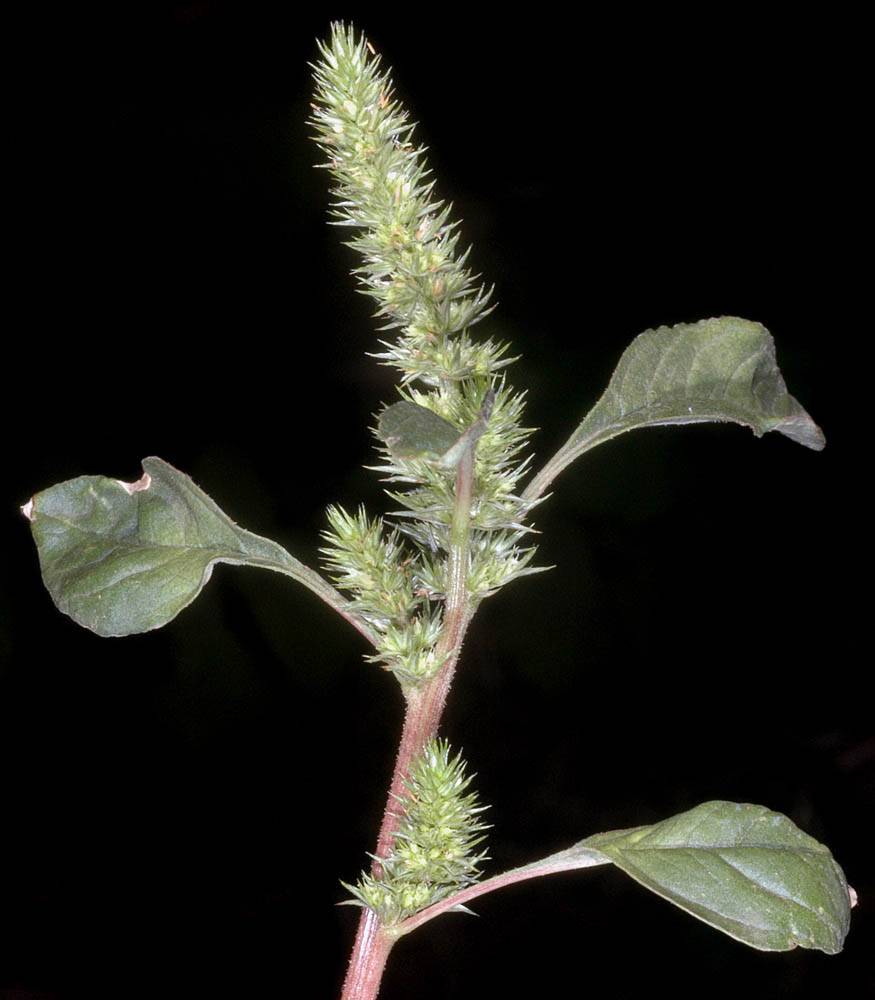Amaranthus hybridus
Amaranthus powellii
slender pigweed, slim amaranth
Powell's amaranth
erect, branched or not, 3–12(20) dm, green or red.
erect, branched or not, 2.5–15(20) dm, green or reddish purple.
blades rhombic-ovate to widely lanceolate; (2)4–12(15) cm, bases wedge-shaped;
margins entire; plane;
tips acute to obtuse;
midveins extending to a spine;
petioles 1–5(10) cm.
blades rhombic-ovate to broadly lanceolate, 3–6(8) cm, bases wedge-shaped;
margins entire; flat to undulate;
midveins extending to a short spine;
tips obtuse to cuneate;
petioles ? blade, 3–6 cm.
terminal and axillary, tightly clustered; lax and nodding; dull green to red, villous;
bracts 2–4 mm;
midveins extending to a spine.
mostly terminal, sometimes axillary; rigid-erect panicles with few branches, green to pale green;
bracts numerous, lanceolate to awl-shaped, 4–7 mm.
perianth segments 5, mostly similar in staminate and pistillate flowers; erect, not overlapping or reflexed, linear to lance-oblong;
midveins extending to spine;
tips acute.
perianth segments 3–5, similar in staminate and pistillate flowers; erect, not overlapping or reflexed, broadly linear to lanceolate;
midveins extending to a spine;
tips acute.
generally at inflorescence tips;
perianth segments of nearly equal length, 2–3 mm;
stamens 5.
perianth segments unequal to subequal, generally at tips of inflorescences;
stamens 3–5.
perianth segments of equal length or 1 slightly longer, 1.5–2 mm;
styles 3; erect.
perianth segments 1.5–3.5 mm;
styles 3, spreading.
ovoid, 1.5–2.2 mm, rugose at tips; smooth below; dehiscence circumscissile.
subglobose to ovoid, 2–3 mm; smooth to slightly rugose at tips; dehiscence circumscissile.
lenticular, widely orbicular to rounded, 1–1.4 mm, red-brown to black; shiny.
subglobose to lenticular, 1–1.4 mm; black; shiny.
=32.
=32, 34.
Amaranthus hybridus
Amaranthus powellii
Disturbed areas, streambanks, roadsides, fields. Flowering May–Oct. 0–700 m. Casc, Owy, Sisk, WV. CA, ID, NV, WA; throughout North America; scattered worldwide. Native?
Amaranthus hybridus has been known to hybridize with A. retroflexus.
Fields, disturbed areas, roadsides, streambanks. Flowering Jun–Oct. 50–1900 m. BR, Casc, Col, CR, ECas, Lava, Owy, Sisk, WV. CA, ID, NV, WA; nearly worldwide. Native.
Bridget Chipman
Bridget Chipman
- Local floras:
CA,
OR,
WA
- Local Web sites:
CalFlora,
CalPhotos,
Flora NW,
PNW Herbaria
WildflowerSearch
iNaturalist (observations)
USDA Plants Database
- LBJ Wildflower Center
- SEINet
- Plants of the World Online
- Encyclopedia of Life
- Wikipedia
- Google Image Search
- Local floras:
BC,
CA,
OR,
WA
- Local Web sites:
CalFlora,
CalPhotos,
Flora NW,
PNW Herbaria
WildflowerSearch
iNaturalist (observations)
USDA Plants Database
- LBJ Wildflower Center
- SEINet
- Plants of the World Online
- Encyclopedia of Life
- Wikipedia
- Google Image Search




